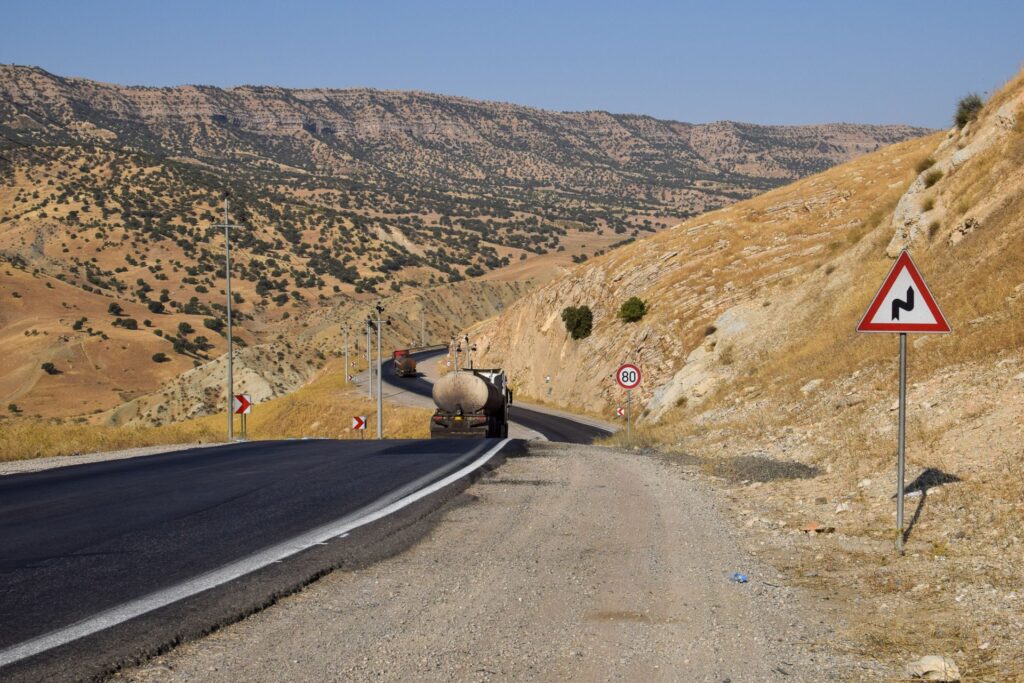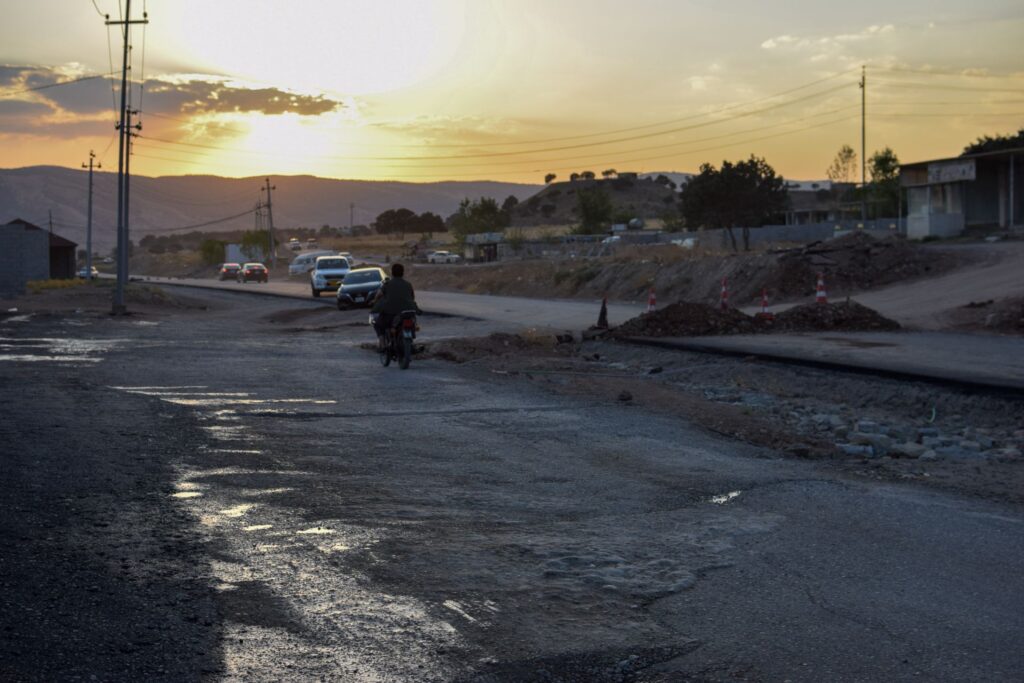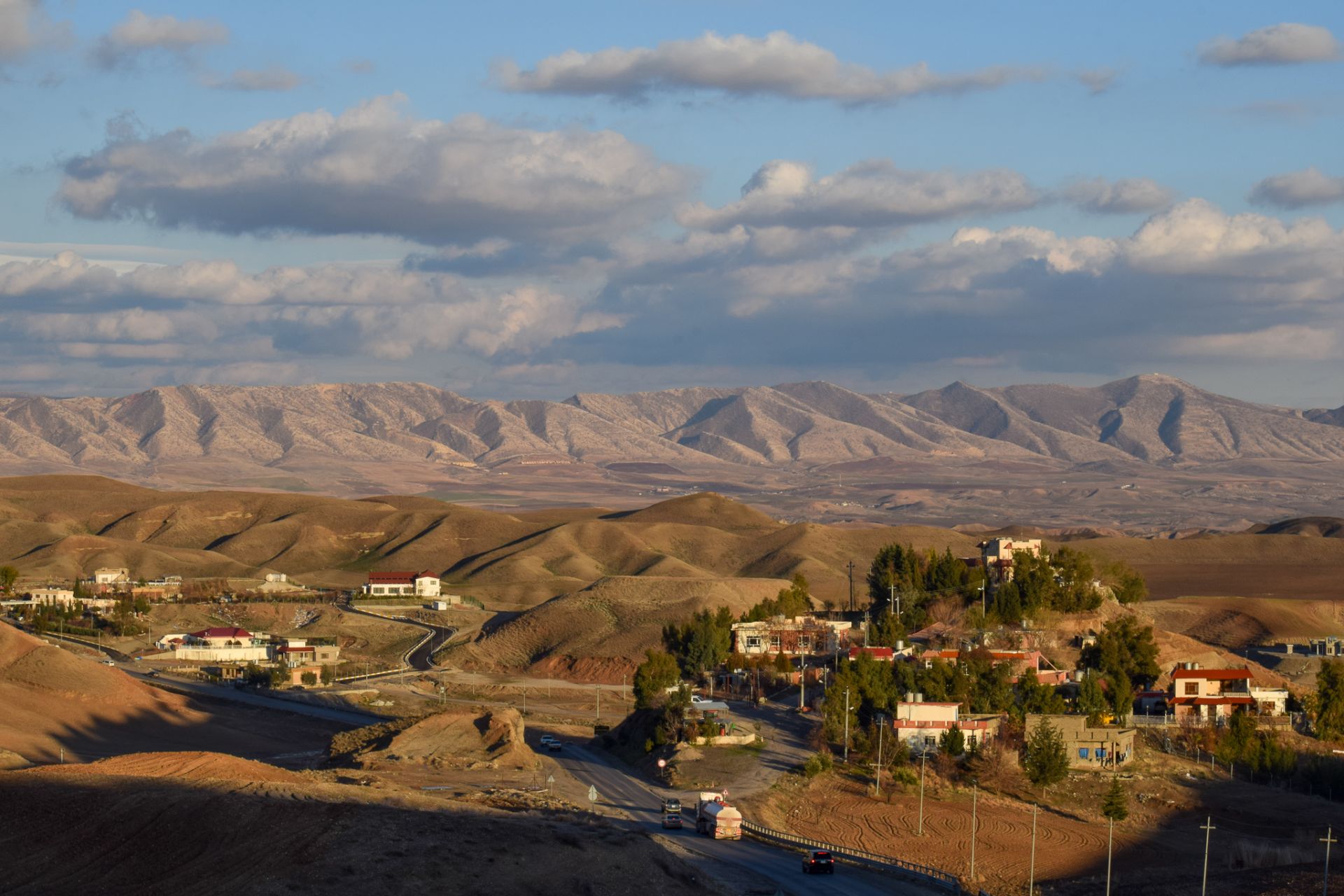It’s a dusty dawn in Sulaymaniyah, in Iraq’s northern Kurdistan Region, and the heat is just beginning to build. After a moment of comfort enjoying strong tea, tangy yogurt and warm bread, I set off on the road between Sulaymaniyah and Erbil.
I’ve made this trip many times and often wonder: Why isn’t there a highway? Why is the main route between the Kurdistan Region’s two largest and most important cities a bumpy, dangerous, two-lane road?
The lack of a smooth and efficient link between the two cities is undoubtedly a headache, but it is also a perfect example of how the Kurdistan Region’s internal divisions make the lives of ordinary people more difficult. Its partitioned transportation network reflects its dysfunctional politics in physical form.
“It is the road to hell,” said Hiwa Khalakan, a shopkeeper. “You can never trust anything on this road. You just have to give yourself to God.
“I was 10 years old when they said this road was going to become a highway, a divided one and everything, and now I am 37 and here we are,” he added, watching as vehicles crawled delicately over a jagged speed bump in his namesake village of Khalakan.
Over the past three decades of self-government, the Kurdistan Region’s two notoriously quarrelsome ruling parties — the Patriotic Union of Kurdistan (PUK) and the Kurdistan Democratic Party (KDP) — have failed to develop a political system that works as a unified whole.
Each party administers its own zone, relics of the civil war they fought in the 1990s: Sulaymaniyah and Halabja governorates are controlled by the PUK, while Erbil and Duhok governorates are the stronghold of the KDP. Neither party is able to meaningfully influence affairs in the opposing area. Always difficult, their relationship has deteriorated significantly over the last two years, making even the most basic kinds of governance nearly impossible.
Yet the Kurdistan Region is still a small place. Business responsibilities and social ties transcend the political boundaries constructed by the parties. Each day, thousands of people get behind the wheel to make the journey. Needs must when the devil drives, as the saying goes.
Granted, it is a beautiful trip. The so-called Smaquli route from Sulaymaniyah to Erbil winds its way through intersecting valleys. Mountain ranges are hazily etched in pale shades of blue. Pomegranate orchards grow in rows next to farmhouses, patrolled by honking, hissing geese.
For much of the distance, however, the road is a single strip of unlined, meandering tarmac. Driving the grinding 125 miles routinely takes more than three hours. It is as if the interstate did not exist and everyone drove from Richmond to Washington, D.C., on a county byway.
“It’s a really bad road. It’s really hard for us,” said Araz Hama Saeed, a bus driver, during a pit stop for a late dinner at the Kurdistan Azad restaurant in Kani Watman village. He makes a round trip between the cities at least once a week. “A road should not be like this if it goes between two big governorates. It’s really tiring.”
It is dangerous, too. Rickety oil tankers and tractor-trailers take sharp curves at high speed and back up traffic when they slow on steep inclines. The cars behind peek out to see if they can seize a risky chance to overtake. The road surface is so broken in key sections that they become chokepoints. Traffic creeps along kicking up dust. At night, the road is an invisible ribbon in the dark with no lighting, median or guardrails.
“We are always scared of the fast trucks on such a narrow road and of how the pavement has been damaged. It causes a lot of problems,” said Arazu Barawi, who runs Kurdistan Outdoor, a tourism agency.
Yet the Kurdistan Region is hardly undeveloped. Several modern highways already exist and others are currently under construction. It is simply a matter of where they are located and what purpose they serve.
The transportation networks within each party’s respective zone are much better than the roads that cross the line of partisan control, especially if they terminate at an international border. The parties take a cut of the customs revenue collected at these crossings, which is a powerful and self-serving motivator to make sure the road is good.
For example, the KDP recently built a modern six-lane, divided highway from Erbil to Duhok, another major city within its zone. An extension then leads to the lucrative Ibrahim Khalil border crossing with Turkey. A fourth ring road designed to international standards is currently being built around Erbil city, with luxury villas and apartment complexes popping up alongside.
To a lesser degree, the PUK has done the same. The drive from Sulaymaniyah to Penjwen and the Bashmakh border point with Iran is relatively smooth. A new highway to Ranya is under halting construction, but driving north from Sulaymaniyah it eventually turns away from Erbil, with new construction remaining firmly within the PUK zone. These teases of what is possible show the parochial mindset of the ruling parties.
“I wish it was two-sided,” Saeed said of the Sulaymaniyah-Erbil road, using the local term for a divided highway or dual carriageway. “We know that highways are four- or even six-sided in other countries, but here it is all one-sided. We wish for a modern highway.”

On the first stretch of the drive from Sulaymaniyah to the lakeside resort town of Dukan, drivers have a smooth run on a modern highway. It is by far the easiest section, leaving plenty of opportunity to enjoy the landscape.
Shepherds bring out their flocks to nibble on the verge. In spring, clusters of almond trees are riots of pink and white petals. From high above, the massive bulk of Piramagrun Mountain frowns down on Fort Suse, a squat fortress built in 1977 by the Soviet Union for the Iraqi army that now serves as a prison for Islamic State group militants.
Travelers encounter the first of five checkpoints on this route just past the town of Tasluja. Each post is staffed by the Asayish, the Kurdistan Region’s internal security service. Asayish units are affiliated either with the KDP or the PUK, depending on the zone. With Kalashnikovs slung over their shoulders, they check IDs, question drivers about their destinations and occasionally search vehicles.
“The checkpoints slow us down,” said Barawi. “Because the trucks and lorries have to be stopped and checked, it causes a very long line of cars in frustrating traffic.”
Ostensibly, the checkpoints are there to ensure security in a country where that cannot be taken for granted, but their political role is unavoidable. They are not only symbolic of which party is in control of a given area but are also a practical way of enforcing partisan interests.
In 2015, the KDP stopped the then-speaker of the Kurdistan Parliament at one of its checkpoints to prevent him from traveling to Erbil and presiding over a session to debate the controversial decision by the leader of the KDP, Masoud Barzani, to extend his term as Kurdistan Region president. Barzani remained in power for another two years.
After Dukan, the road narrows to just two lanes and twists its way through rolling farmland framed by flat mountain ridges on either side. Many drivers stop at Kani Watman, which marks the psychological halfway point to Erbil. It is famous for its cluster of restaurants serving Kurdish food. After a big meal, tea flows freely to give a much-needed boost to complete the rest of the trip.
It is important to stay alert. Car crashes are common. According to the Kurdistan Regional Government’s (KRG) General Traffic Police Directorate, at least 445 people were killed and another 7,250 were injured on the region’s roads last year. While a habit of not wearing seatbelts certainly contributes to the death toll, cars and trucks traveling head-on at high speed on two-lane roads are a major factor in the lethality of crashes.
“A modern highway would be safer,” said Araz Abudullah, who works at the Kurdistan Azad restaurant. “It would bring more people. This is a strategic road for tourists and a bridge with the rest of Iraq.”
The poor quality of the road surface also wears down both drivers and their vehicles. Smaquli is a notorious chokepoint caused when the road has to cross over the top of a small dam. For years, the approach would flood during winter rains. The government neglected the problem, and eventually, an opposition politician known for populist stunts hired an engineering crew and raised the road’s height by several meters.
Nevertheless, problems in the area continued. Car-swallowing potholes caused by the constant truck traffic were left to fester. This spring, frustrated residents protested, blocking the route for hours. The PUK, which controls the area, scrambled to respond, and the road is currently undergoing major repairs. In the meantime, however, this vital route is reduced to a gravel surface. The party may be keen to placate residents ahead of tough elections expected next year, but most people are sick of such poor governance.
“It’s more than just elections,” said Azad Kamal, sitting in a cloud of dust kicked up by the traffic passing a roadside teahouse in Smaquli. “Even during the civil war, the Baathist regime, and since then, this town has never been served. … Everything always falls on the people.”
Shortly after Smaquli, travelers pass into KDP territory. The farms and mountain views are the same, but there are subtle changes. The political iconography on roadside billboards no longer depicts Mam Jalal, the bespectacled former leader of the PUK who died in 2017, but features Barzani, the KDP’s aging chieftain.
The rest of the run to Erbil, however, remains a narrow, bumpy road with heavy traffic and periodic checkpoints. After a particularly harrowing stretch on either side of the village of Bakhchay Bchuk where the road snakes through a ridge of hills, the Kurdistan Region’s capital city finally emerges on the plain below, partially hidden under a permanent blanket of dust and pollution. Just like on the way out of Sulaymaniyah, the road here becomes a proper highway and a reminder of what is possible.

There are other routes that drivers use to get between Sulaymaniyah and Erbil, but each has its own problems. Politics remain the key factor.
Divided highways link Kirkuk with both cities, forming two sides of a right triangle where the Smaquli route runs on the hypotenuse. Between 2014 and 2017, Kurdish forces were in full control of Kirkuk and most drivers chose to go through the city because of the better roads.
This changed when the Iraqi security forces and the Popular Mobilization Forces (PMF) took the area from the Peshmerga on Oct. 16, 2017, in the aftermath of the Kurdistan Region’s independence referendum. Since then, some Kurdish travelers believe traveling the Kirkuk route carries extra risk, given the presence of PMF militias. Deadly clashes on Sept. 2 between the city’s different ethnic populations may have reinforced this perception.
Foreigners must hold a visa issued by Iraq’s federal government to travel from the Kurdistan Region to Kirkuk — a passport stamp from the KRG is insufficient — making it an inconvenient alternative for international tourists and businesspeople just going between Sulaymaniyah and Erbil.
Another route runs through the city of Koya, but this road is also not a divided highway, and for years it was full of truck traffic that tore up the blacktop. Protests and complaints from locals finally forced the authorities to ban the heavy vehicles from transiting through the city. With no bypass, truck drivers switched to the Smaquli route and caused the same problems there.
KRG Minister of Construction and Housing Dana Abdulkareem Hamasalih, whose office is responsible for building intraprovincial roads, said that the KRG has a plan to build a divided highway between Erbil and Sulaymaniyah via Koya and a tunnel under Haibat Sultan Mountain. He estimated that this would cost around $370 million to complete. “However, the economic crisis created difficulties for continued implementation,” Hamasalih said.
Since 2014, when Iraq’s federal government first cut off budget transfers to the KRG in retaliation for Erbil’s decision to start independent oil exports, the Kurdistan Region has endured a prolonged economic decline. The KRG regularly misses salary payments to employees at government ministries, and public services like electricity and water are notoriously bad.
Financial pressures have certainly limited what projects the KRG can take on, but modern, divided highways are nevertheless being laid. The minister noted that the KRG has built 56 miles of divided highways since July 2019, when the current cabinet took office.
Hamasalih denied there was any political reason that priority seems to be given to roads within partisan zones, rather than those that cross between them. The ministry does “its best to provide services for all parts of the Kurdistan Region,” he said over a messaging app.
Out there on the road, however, it is clear whom people blame for the KRG’s failure to build a modern highway between its two biggest cities. Whatever negative role Baghdad plays in the Kurdistan Region’s finances, the KDP and PUK have had ample opportunity to work together and deliver for residents but have consistently failed to do so.
“If the parties don’t work together, there will never be a road,” said Herish Hassan, sitting at the Smaquli teahouse. “We are disappointed. … Nothing has been done.”
In Kani Watman, Saeed resignedly agreed. “You know how the Kurdish government is,” he said, before hoisting himself back into his bus, switching on the headlights and heading back into the night.
Sign up to our mailing list to receive our stories in your inbox.



